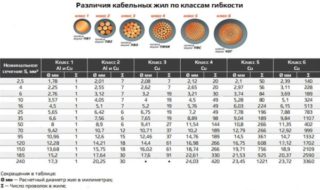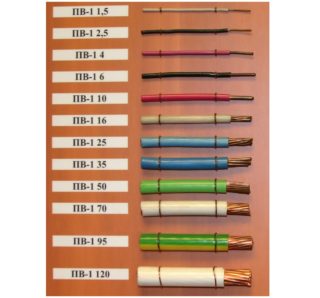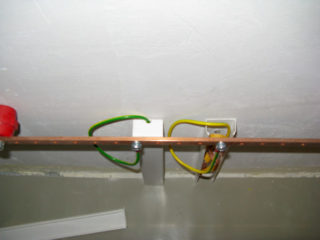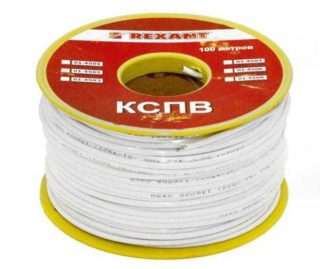Installation wire PV 1 is used for laying under the layers of building mixtures, for example, plaster, in cable trays, building voids and pipes. Due to the large number of advantageous features, it is actively used not only in industry, but also in everyday life.
Decoding of the name and nomenclature of wires PV1
The main advantage of the cable is a combination of reasonable cost with good mechanical and electrical characteristics. It is necessary to deal with the decoding of the name and the existing types of wires PV1 produced and used in Russia.
The abbreviation PV-1 is deciphered as follows:
- The letter "P" means that we are talking about a wire. In addition to wires, it can use the letter "Ш" or "К", cords and cables, respectively.
- The letter "B" indicates the type of insulation material used. In a particular case, this is insulation made of polyvinyl chloride. Due to its stable physicochemical properties, this insulation is often used as a dielectric.
- The number "1" indicates the class of flexibility. The lower the number, the greater the bending radius of the wire, cable, cord, etc.
There are installation and assembly wires. The former include modifications that are designed for long-term use in one position, the latter can be re-planted repeatedly. All modifications of the PRV wire, with the exception of PV-3, are installation ones.
Special attention should be paid to the types of PV-1, which are produced by domestic industry. In accordance with GOST No. 6323-79, all wires of this brand should have the following mass dependence of the cross section:
| Nominal section and number of cores, mm.kv | Mass 1 km of cable, kg | Max outer diameter mm |
| 120 | 1060 | 17,5 |
| 95 | 956 | 17,00 |
| 70 | 691 | 15,00 |
| 50 | 511 | 13,00 |
| 35 | 362 | 11,00 |
| 25 | 260 | 9,80 |
| 16 | 172 | 8,00 |
| 10 | 107 | 6,40 |
| 8,0 | 80,2 | – |
| 6,0 | 65 | 4,90 |
| 5,0 | 54,8 | – |
| 4,0 | 45 | 4,40 |
| 3,0 | 37,7 | – |
| 2,5 | 30 | 3,90 |
| 2,0 | 26,2 | – |
| 1,5 | 19 | 3,30 |
| 1,0 | 13 | 2,80 |
| 0,75 | 10 | 2,60 |
| 0,5 | 8 | 2,40 |
All brands of PV-1 wires are single-core.
Specifications
Mechanical
 By mechanical parameters is meant the resistance of the cores and the insulating layer of the wire to atmospheric influences, flexibility, compression and rupture.
By mechanical parameters is meant the resistance of the cores and the insulating layer of the wire to atmospheric influences, flexibility, compression and rupture.
- One of the main features of all brands of wires is the ability to bend. PV-1 cannot be called flexible. The bending radius is not more than 10 outer diameters of this wire.
- The range of operating temperature ranges from -50 to +70 degrees Celsius.
- A significant advantage of this brand is moisture resistance. The test results showed that at a temperature of +30 degrees the wire does not lose its performance even with a relative humidity of 100%.
- It has good resistance to acoustic, vibrational, mechanical, thermal, chemical and other influences.
Another advantage of the modification is that it does not spread combustion. Due to this feature, the wire was taken as the basis for the high-voltage PVV-1, which is actively used in the automotive industry.
Electric
It is electrical characteristics that are most often fundamental. In this case, PV-1 is showing its best side.
- The electrical design is intended for use in electrical AC networks with voltages up to 450 V and a frequency of not more than 400 Hz. If we are talking about DC networks, the voltage should be no more than 1 kV.
- Resistance force, first of all, depends on the cross section of the wire. For example, 0.5 mm.kV resistance is not more than 0.015 MΩ, otherwise there will be malfunctions.
- Feature PV-1 - stable parameters. Even during use, the electrical resistance does not differ from the rated parameters by more than 120%.
All studies are conducted on a wire 1 km long and at an operating temperature in the range of + 70-90 degrees.
Design Features
PV-1 is a single-core wire. It can be used to connect only one equipment. An electrical component is made of high-quality copper, which is previously subjected to tinning.
PV has an extremely simple design. Includes the following elements:
- Insulation material covering the surface of the wire. Consists of polyvinyl chloride. It has a color coding, which is selected by the customer, if it is not a grounding cable.
- Current-carrying conductor of copper. Its structure depends on the cross section of the cable.
In the range from 0.5 to 10 mm. Sq. Veins are cast, from above I can be applied multiwire.
Scope and service life
There are no strict restrictions on the use. It is actively used for switching stationary-type electrical installations and lighting systems. Also, the electrical design is operated on machines in which it is required to reliably connect several mechanisms or work units.
A wide range of applications is due to the following advantages of PV-1:
- PV-1 and PV-3 have minimal linear expansion.
- The assembly wire is characterized by high strength, due to which it transfers numerous and tangible mechanical influences.
- The insulation is made of polyvinyl chloride, a feature of which is self-extinguishing.
- On the surface and under the shell, the likelihood of developing pathogenic microflora is excluded, which will adversely affect the performance, data transfer quality and service life.
Wires can be placed inside plastic and metal pipes, cable trays and inside equipment. Yellow-green modifications are used to implement the grounding system.
The operational life of installation wires, subject to all rules of use, reaches 15 years or more. In comparison with a large number of other modifications, these are high indicators.






